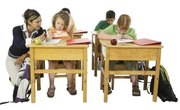Many students have physical or learning disabilities that make it difficult for them to learn through traditional styles of instruction. To help these students succeed, school systems offer an altered curriculum and/or instructional approach. These changes are called modifications, adaptations or accommodations.
Definition
There are no set definitions for the terms modification, adaptation and accommodation. As a result, these terms often get used imprecisely and interchangeably. Generally, modifications and adaptations refer to individualized curriculum changes that reduce the difficulty and size of a student's workload. Accommodations, however, usually refer to tools and techniques that help students keep up with a standard workload identical to that of their peers. In other words, modifications and adaptations change what a student is expected to learn while accommodations change how a student learns.
Population
Special needs populations include students with learning disabilities, ADHD, autism, emotional disturbances, low IQ, blindness, deafness and mobility limitations. For academic subjects, students with only physical limitations will usually receive accommodations, not modifications or adaptations; for gym class, however, they may follow a modified or adapted curriculum. Students with ADHD who have a high IQ may also need only a few accommodations to succeed; more severe cases may warrant a modified or adapted curriculum. The same is true for children with autism and learning disabilities. Gifted children and children who speak a language other than English are also considered part of the special needs population; they may also receive modifications or accommodations.
Features
Students receiving modifications or adaptations are usually given less input; this means they receive less material to memorize or learn, and their assignments are shorter and easier than those given to the rest of the class. Modifications can also apply to students' output. They will be expected to recall or generate fewer details, and they may not be required to participate at the same level as their peers. Students requiring a modified or adapted curriculum have their own individual goals, and they take special modified versions of standardized tests.
Examples
Often students with modified or adapted curricula also receive accommodations. Accommodations for input include sign language interpreters, books in Braille and audio-taped books. Output accommodations include allowing a student to take an oral test instead of a written test. Other accommodations include allowing the use of calculators, providing graphic organizers and giving a student extra time to complete an assignment. If accommodations allow a child to succeed, he will not need a modified or adapted curriculum.
Benefits
Modified or adapted curricula allow students with special needs to continue learning at a pace they can keep up with. They also allow them to take part in the social aspects of student life. A modified physical education curriculum may make it possible to expect a student with physical disabilities to participate in an athletic activity, and the learning and fun that goes with it.
Related Articles
References
Writer Bio
Linda Basilicato has been writing food and lifestyle articles since 2005 for newspapers and online publications such as eHow.com. She graduated magna cum laude from Stony Brook University in New York and also holds a Master of Arts in philosophy from the University of Montana.











